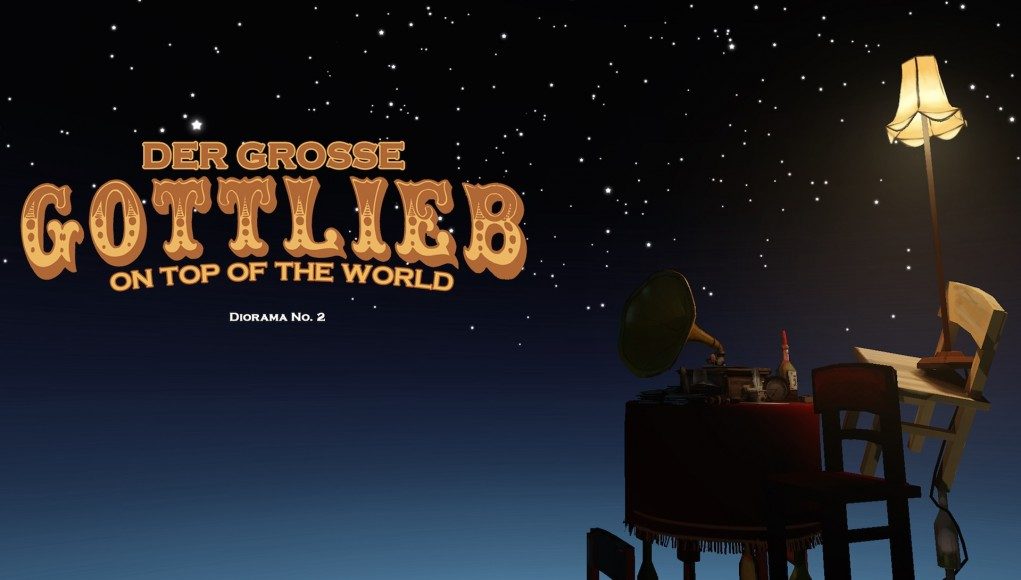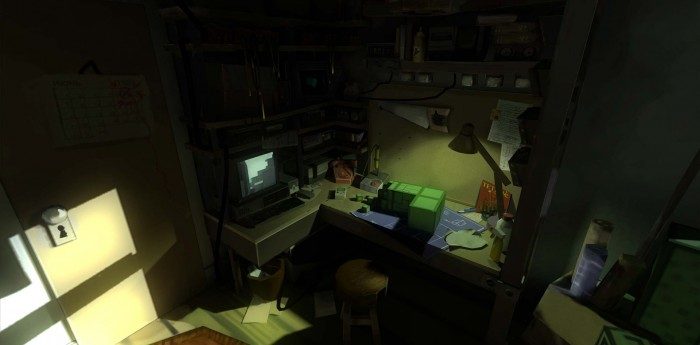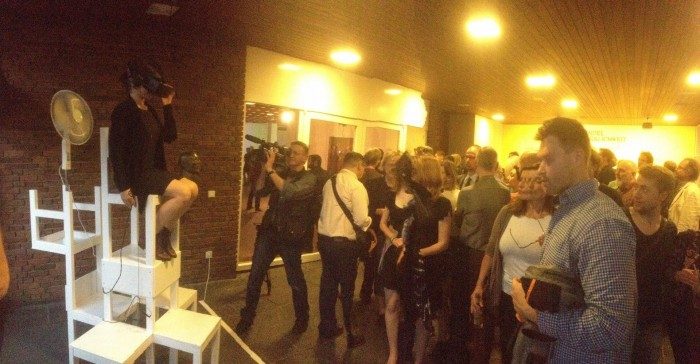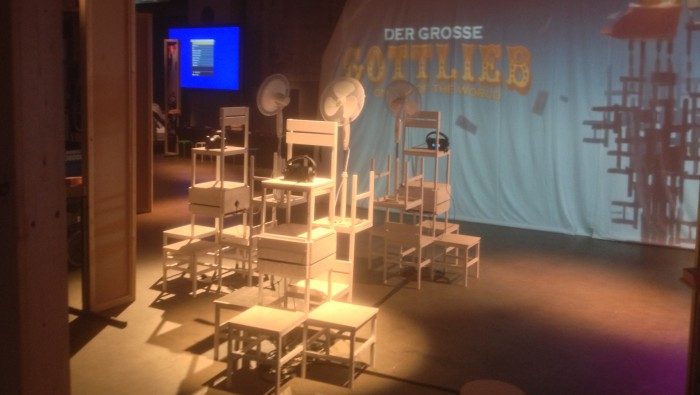Daniël Ernst is the founder and sole member of The Shoebox Diorama, a production company dedicated to exploring the brand new artistic possibilities of a new genre, the virtual reality diorama.
Ernst has thus far eschewed VR’s early rush for cheap thrills and jump scares and adopted an altogether more contemplative, creative, and thoughtful approach to his experiences.
The term ‘diorama’ has roots in the early 1800’s but these days is generally taken to mean ‘recreation of a scene’. Ernst transfers this core idea into virtual reality, and takes advantage of the technology’s immersive qualities to create, as he puts it, “…fantastical hand-painted 3D environments in which the user has to but one thing, be amazed.”
Ernst’s first title for the Oculus Rift, Blocked In, is a beautiful, melancholic experience in which you’re placed into a world juxtaposing the mundane with the surreal. As this is a diorama, you’re rooted to the spot, but allowed to glance around the space and explore the lavish attention to detail Ernst brings to his environments. As you explore, you passively witness the end of the world unfold outside your window as giant Tetris blocks fall from the sky, slowly but surely blocking everyone in.
Ernst’s followup however was to adopt a more upbeat tone, if no less surreal. Der Grosse Gottlieb, has you assuming the titular character (the world’s greatest acrobat), as he attempts to reach the stars atop an enormous tower built from chairs in order to “…knock on heaven’s door to visit the stars.” A vertiginous yet amazingly tranquil creation, Ernst yet again indulges in his passion for minute detail as he weaves intricate touches and animations, revealed as you explore your surroundings and gaze contemplatively at the stars.
Der Grosse Gottlieb won Ernst Proto and Unity Award nominations last year, later evolving into an installation at the Akademie der Kunste in Berlin. The elaborate construction aped the virtual tower of chairs and employed a fan pointed at the user as they sat on the topmost chair wearing an Oculus Rift.
The experience has now been updated and re-released on Oculus Share, featuring one of the coolest VR menu systems I’ve ever seen – one that has the menu ‘items’ presented beyond a cutout in a wall, requiring the user to lean in to the scene to select. If you’ve not yet tried it, you can check it out here.
We wanted to find out more about Ernst and his thoughts on the emerging experiential genre VR dioramas occupy and he kindly agreed to the following interview.
Road to VR: Most people who are into VR probably know your earlier work, Blocked In. Was that your first foray into virtual reality? What was the central idea behind it?
Ernst: The Shoebox Diorama was my first foray into VR, but not my first foray into stereography. I think it was somewhere in 2007 when I started experimenting with interactive illustrations. Or to be more precise how one could apply optical illusions to tell a story. Kind of like the illustrator’s equivalent of how an illusionist performs a trick.
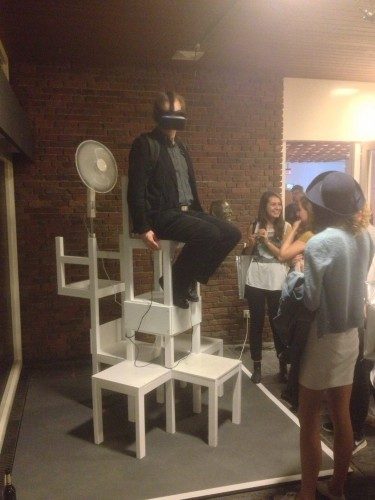 You see, an illusionist grounds the audience with something familiar. Be it a dove, a bunch of flowers or an albino tiger if you’re visiting Siegfried and Roy. Then it takes that familiar thing and does something amazing with it, after which the object is returned to normal. A narrative is used to bind everything together.
You see, an illusionist grounds the audience with something familiar. Be it a dove, a bunch of flowers or an albino tiger if you’re visiting Siegfried and Roy. Then it takes that familiar thing and does something amazing with it, after which the object is returned to normal. A narrative is used to bind everything together.
Without the narrative it’s just a trick. And most tricks are done a hundred times over. It reminds me of a story about Houdini. Houdini had this trick where he would escape from handcuffs. The trick got copied by other escape artist until the public stopped believing it. Houdini however improved on the trick by hiring a police officer to put on the handcuffs for him. This simple “story” revived the trick. Police officers are to be trusted right? This story always stuck with me.
I tried to apply this approach to illustration which resulted in a collection of stories about weird and wonderful characters, whose stories were told through optical illusions, some ended up in illustrations, others in gameplay experiments. One of which used anaglyph glasses in a functional way. Which is where I experimented with stereo photography and other such things. But none of those projects I felt completely satisfied with.
It wasn’t until the Rift was announced that things clicked. VR allows one to play with the perception of reality in a very direct way.
Every diorama in the The Shoebox Diorama series is an illusion of some sorts. These illusions won’t work if the presence is not exactly right or if interaction is too dominant. Being in a virtual space with a good amount of presence is a full experience in itself and that should be the most important thing.
Blocked In is the first diorama in the series and served as a proving grounds for dioramas to come. In it I tried to figure out what the best way is to create a convincing space. I experimented with positional audio, compositions (omni-directional compositions, lock framing and other fanciful tricks. Don’t know if those are the correct terms, but they sounded official when I was working on Blocked In) and the rhythm of a scene. Diorama type experiences are small enough for me to have full control over the experience. And most importantly they are a lot of fun to create!
Road to VR: Tell us more about the origins of Der Grosse Gottlieb. Where did the character come from? Does he have a backstory?
Ernst: The basic idea of the Gottlieb came from some playtests of Blocked In. People would reach out and try and grab the tetris block on the table. Of course they would never be able to. There was something romantic about that notion and it kind of reminded me of the boy who tried to reach for the moon.
This premise served as the core idea and after some brainstorming lead to the idea of an acrobat who tried to reach the stars. It also tied in perfectly with the old Romantic paintings of Caspar David Friedrich; his landscape paintings usually depicted small figures against an epic landscape staring into the wild contemplating life, love, and other such heavy emotions people deeply felt during the Romantic era. I bet Friendrich would have enjoyed the Cure.
Road to VR: How did the project go from VR diorama to art installation project? Was it something you were approached to do?
Ernst: Der Grosse Gottlieb is an installation even without the physical object. It’s all about incorporating outside stimuli into the virtual experience and using that to tell a story. The basic setup is a fan, mic, and Rift plus PC. People have been making their own installation setup at home, which is pretty awesome (and sometimes quite dangerous…).
The installation served as a means to create an environment for the player to be fully immersed in and hide the pc and mic so people would not quite know what to expect or how it worked.
But to be honest it was mostly me enjoying the experimentation process.
Road to VR: What pleased you about the project and what would you differently next time?
Ernst: I really liked how the interaction is a natural part of the experience. For me Gottlieb is superior to Blocked In interaction-wise and a precursor of things to come.
One element of the design I particularly liked was the addition of the microphone. The microphone streams in a livestream of the environment. I hooked it up to my positional audio system which made the live stream fade in when the visitor would look down and the stream would fade out when the visitor would look up. This way the player would feel like he was looking down from a great height. It also emphasized that below life is busy, and life among the stars is peaceful.
Another thing I liked was the process of designing the installation itself and showing it at festivals. It’s a tough process, but fulfilling and completely different from showing a traditional game at a festival. Things will go wrong, mistakes will be made, things will break down but everything can be fixed if you stay cool.
Another thing I wanted to tackle is to share more of the actual design process of the dioramas. I did a lot of research with Blocked In about compositions, audio design, interface navigation and other such things. The problem is that doing a proper writeup takes time. I’m going to add an audio commentary feature to the release versions of the dioramas which will go in depth into their creation.
Road to VR: Has the installation lead to other interesting projects?
Ernst: Well it certainly has led me to interesting places to show the installation. I was part of the ‘Vertigo of Reality’ exhibition in the Akademie der Kunste in Berlin. My work was shown among artists such as Marina Abramovic and Olafur Elliasson. The opening of the Berlin art week took place during the opening of the Vertigo of Reality exhibition, so there were thousands of people standing in line to get in. That was pretty amazing.
But I think the most fulfilling thing will be the dioramas I’m planning to make in cooperation with a children’s hospital.
Road to VR: Do you think virtual reality presents an opportunity for artists that traditional interactive mediums such as games do not?
Ernst: Yes! VR lends itself excellently for creating more reality defying types of experiences. An architect can create buildings that don’t have to obey the laws of physics, you can gender swap someone and make him reflect on his body and so on. It’s basically a way to reconstruct reality.
Road to VR: We were lucky enough to get a sneak peek at your forthcoming project, The Pigeon Man at Gamescom last year. Can you give us a preview of what’s to come and when we can expect it?
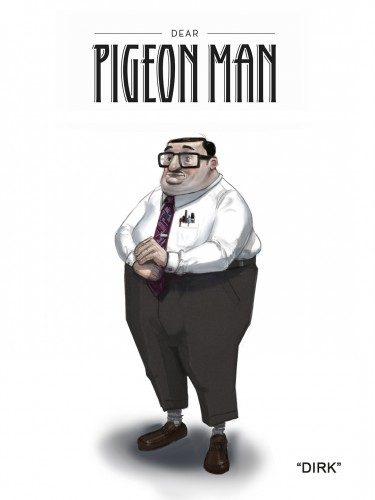 Ernst: The Pigeon Man is an intimate diorama game for the Oculus Rift about an old pigeon post office and the weird and wonderful people who will tell its story. The game consists of four episodes in which you will meet a character and explore his space. Every character has a distinct way of communicating with the player which will be reflected in the interaction. The game can also be played by disabled people (it could theoretically be played by blind people). And last but not least the project is co funded by the creative industries fund NL.
Ernst: The Pigeon Man is an intimate diorama game for the Oculus Rift about an old pigeon post office and the weird and wonderful people who will tell its story. The game consists of four episodes in which you will meet a character and explore his space. Every character has a distinct way of communicating with the player which will be reflected in the interaction. The game can also be played by disabled people (it could theoretically be played by blind people). And last but not least the project is co funded by the creative industries fund NL.
The Pigeon Man will be the fourth diorama in The Shoebox Diorama series and is the first full length diorama. The Pigeon Man will be released on mobile platforms, Steam, and elsewhere when it’s done! Blocked In & Der Grosse Gottlieb will also get a official release soon before or after.
You can find out more about The Shoebox Diorama at the website, and check out Blocked In here, and Der Grosse Gottlieb over on Oculus Share.

